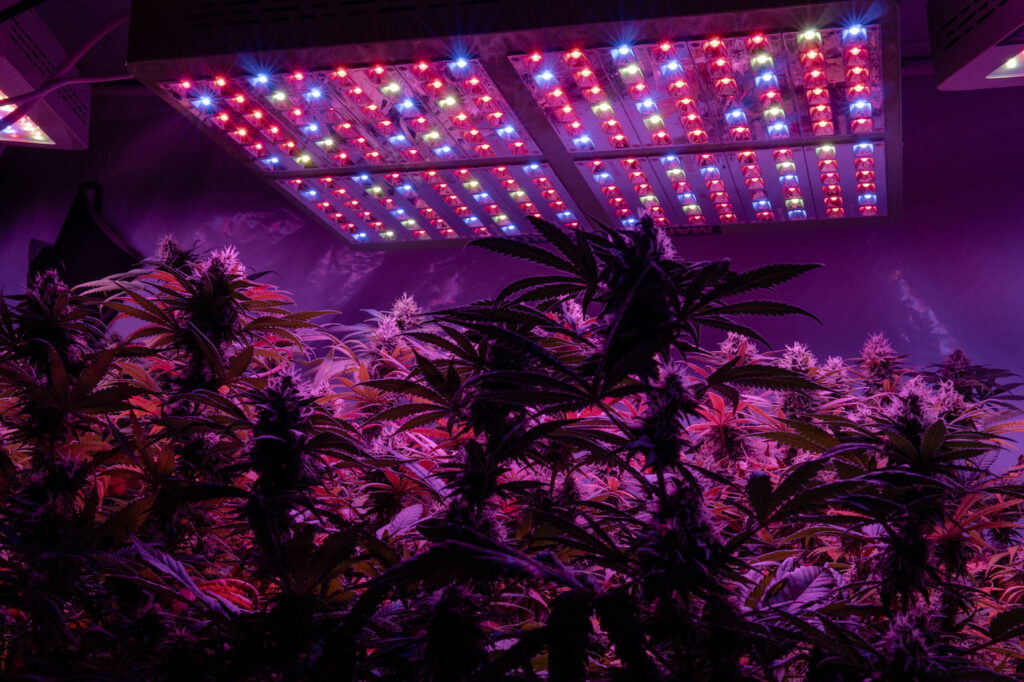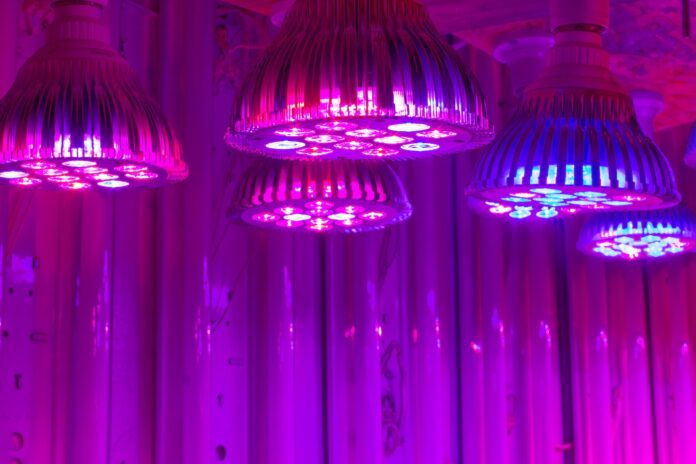Grow lights can never truly replace the sun, but they can get pretty close. For many cannabis cultivators, a properly optimized lighting solution is the key to a bountiful and lucrative harvest.
Lights designed for indoor cultivation have myriad benefits. They produce an array of visible and ultraviolet-visible (UV) spectrums capable of stimulating plant growth. Light-emitting diode (LED) lights can integrate with programmable controllers to achieve different intensities and wavelengths, optimizing output throughout the entire plant life cycle. With the right controllers, growers can run different light recipes based on the stage of plant growth.
It’s important to note that not all grow lights are created equal, and each cultivator has unique needs. By choosing the right grow light at the start and spending the time dialing in spectrum and intensity, cultivation facilities can become more efficient and grow bigger buds.
Consider the power requirements
While more wattage may seem like an input for more light, it’s not always the case. The wattage listed by a light manufacturer refers to the amount of energy a light requires to operate. The type of fixture and efficacy of that fixture determines how much light is produced.
Wattage is an important factor to consider when looking at an electric load to ensure the circuit doesn’t overload and trip the breaker. The average circuit can typically handle a 20 to 30-amp load.
Before purchasing, look at the efficacy of the light fixture, a number listed in micromoles per Joules to tell you how much light the unit will produce. Light manufacturers will sometimes list the efficacy number, but if they don’t, it can be calculated by dividing the number of watts a fixture uses by the input voltage.

Lighting spectrum and intensity
A grow light’s main function is to provide the ideal spectrum and intensity for a plant’s needs at a given stage of life. Tech-savvy cultivators can program custom light recipes consisting of specific wavelengths and differing amounts of photosynthetic active radiation (PAR) to meet a plant’s evolving needs.
When plants create new vegetative growth, they use cool, blue light most effectively. Blue light is particularly useful in promoting vegetative growth because it stimulates chlorophyll production and regulates processes like photomorphogenesis, which is essential for leaf expansion, stem elongation, and overall plant health.
On the other hand, plants shift their focus from vegetative growth to reproductive growth during the flowering stage to create flowers and fruits. Red light is critical during this stage because it plays a key role in triggering the flowering process through photoreceptor proteins called phytochromes. Phytochromes absorb red light, signaling to the plant that it’s time to transition to the reproductive phase.
Light intensity refers to how much PAR is available for photosynthesis. The light created is measured using a quantum meter, which will provide a reading for the photosynthetic photon flux density (PPFD). This is a measurement of how many photons are failing within a given area every second. It’s typically expressed in micromoles per square meter per second.
The daily light integral (DLI) requirement refers to how much PAR plants receive over 24 hours. The DLI will increase as the plant grows.
Young plants require minimal PAR to sustain growth, but as they age, more light is needed to promote the creation of energy within the plant. Clones and seedlings prefer around 18 hours of low-intensity light each day.
As plants create new vegetative growth, they become capable of absorbing more light. As a result, their DLI must increase significantly for the entire 18-hour “lights on” period. When plants move to flower, they need an even higher DLI but over a shorter light cycle of 12 hours.
Controlling your lights
Many grow lights have built-in controls that allow users to adjust the intensity and spectrum produced. Typically, lights will have a dimming knob to adjust the intensity based on the canopy height and stage of plant growth. Some lights have more advanced integrated controls that allow users to run programs or recipes for different spectrums and schedules based on specific stages of plant growth.
Many light manufacturers have teamed up with software developers to create advanced controllers capable of tuning lights using programmable recipes that are optimized for certain stages of plant growth. If lights have dimming capabilities, controllers will be able to communicate using a 0 to 10-volt electrical signal to adjust the intensity up or down. A light capable of multiple spectrums will utilize varying types of diodes that can be turned on or off depending on the desired wavelength.
Many high-end controllers integrate with sensors to automatically make changes to the type of light being produced. Based on programmed set points, lights can adjust to maintain the optimum levels throughout the day. This type of feedback is useful in greenhouse growing where lights need to be lowered in high-sun conditions and increased in low-light conditions.
Maximizing your grow light’s potential
Matching your light spectrum and intensity for each stage of the cannabis life cycle allows plants to flourish and reach their full genetic potential. By utilizing controllers and sensors, a grower can create custom light recipes to match the day-to-day growth of plants using a single light fixture. With this optimization level, you can dial in your lights to achieve amazing results in your garden.










[…] marketplace with a sensitive product requires a solid risk plan. Hazards like fire risks from grow lights, worker safety concerns, extreme weather threats, and rising cyber-fraud pose continuous […]
[…] a similar hindrance at Hightops, a medical dispensary in Colorado Springs, Colorado, by letting in natural light via a transparent window in front of partially frosted interior […]
[…] cannabis cultivation experience came to life with 180 realistic cannabis plants, two dozen grow lamps, and some real equipment from STIIIZY’s indoor […]
[…] constantly forward by not only economic but also ecological imperatives. Automated systems now control lighting, irrigation, and climate, optimizing plant growth conditions and maximizing yield while minimizing […]
[…] Grow lights are the cornerstone of any indoor or light-assisted greenhouse cultivation facility. After all, light is the driving force behind photosynthesis, which creates all the energy within a plant. […]